Move quickly and misinform: How direct provision centres became a catalyst for far-right activism in Ireland
The first in a four-part investigation into the growth of far-right activity online in Ireland explores how an anti-immigration agenda infiltrated local activism.

This is the first of a four-part series published today and tomorrow by Noteworthy and TheJournal on the growth of far-right ideology on Irish online networks, its influence and impact on real-life protests and events and the political endgame for some of its proponents.
Here, Cónal Thomas looks at how the direct provision system provided fertile ground for the language and tactics of the far right to take root in Ireland.
BEFORE A SMALL, animated, network of Irish far-right groups emerged online in an attempt to use the Covid-19 pandemic to recruit members, Ireland’s system of accommodating asylum seekers acted as a catalyst for far-right activism.
For 20 years, the State has placed international protection applicants in direct provision centres as asylum applications are processed – a system widely criticised as slow, expensive and cruel.
Amid increased pressure in mid-2018 the Department of Justice & Equality began contracting private hotels and B&Bs in rural areas.
It raised questions among locals in villages like Rooskey, Carrickmacross and Oughterard about the Department’s plans. It also provided fertile ground for far-right misinformation to spread.
The first physical manifestation of this new wave of anti-immigrant sentiment occurred in November 2018.
Plans to accommodate 100 asylum seekers at a hotel in Moville, Co Donegal, a coastal town on the Inishowen peninsula, led to an arson attack at The Caiseal Mara. Gardaí said they believed the attack was deliberate.
Before this attack, concerns had been raised locally about the impact that accommodating 100 people in Moville – which has a population of 1,400 – would have on the town with locals expressing both support and trepidation.
It is a common theme later seen in other rural towns. Locals felt they had not been properly consulted by Government over plans to accommodate asylum seekers in their area at such short notice – a fear we’ll later see was seized upon by far-right actors.
In the end, the Department abandoned its plan to house people in Moville.
 The Caiseal Mara Hotel in Moville, Donegal, following an arson attack in 2018.
The Caiseal Mara Hotel in Moville, Donegal, following an arson attack in 2018.
Shortly after this arson attack, far-right social media lit up as word spread that more towns were being earmarked for asylum accommodation.
Far-right activists had already been organising online at this time.
Before Ireland’s prominent far-right figures were removed from mainstream social media platforms, and before messaging accounts like Telegram and 4Chan became new destinations for them, Facebook and YouTube functioned to allow activists to promote far-right talking points.
Rowan Croft, a builder by trade and former British soldier broadcasting under alias Grand Torino, became a key figure among anti-immigrant activists.
Croft, who has been pictured with Italian Lega Norda leader Matteo Salvini, an Italian politician with anti-immigration views whom he described in 2019 as “his best pal”, frequently promoted anti-immigration views on his YouTube channel.
His YouTube channel – which was recently disabled – frequently promoted far-right conspiracies and what he believed was a “cultural Marxist” agenda at work in Ireland.
By October 2019, he had 19,000 subscribers on his YouTube channel. It had, according to a recent report on European far-right activities, 26,500 followers before it was closed down.
Croft at this time was self-funded, selling merchandise online. In addition to his interviews with far-right figures, he travelled to towns earmarked for direct provision centres and broadcast live to his followers.
In late 2018, Canadian far-right activist Lauren Southern visited Ireland, a move that alarmed anti-racist networks.
Southern – who was interviewed by Croft on his YouTube channel – had previously claimed that 2017′s Quebec mosque shooting was carried out by Muslims and was a frequent proponent of the ‘Great Replacement’ theory – a conspiracy theory later espoused by Irish far-right figures.
This is sometimes framed in the language of a ‘plantation’ in Ireland, in an attempt to draw on the emotional legacy of Ireland’s experience of the British Empire.
Ireland’s far-right rhetoric often combines anti-immigrant tropes with anti-abortion rhetoric, furthering the native Irish ‘replacement’ theory.
 Rowan Croft, aka Grand Torino, pictured left broadcasting at an anti-racism rally at Rooskey in February 2019. Anti-racism demonstrators are pictured on the right.
Rowan Croft, aka Grand Torino, pictured left broadcasting at an anti-racism rally at Rooskey in February 2019. Anti-racism demonstrators are pictured on the right.
Three months after the fire at the Caiseal Mara, Croft attended an anti-racist demonstration at a rally in Rooskey, on the Leitrim-Roscommon border, which had also been earmarked to provide accommodation for asylum seekers at the former Shannon Key West Hotel.
The premises became the target of an arson attack in January 2019 which Gardaí suspect was planned days beforehand. Gardaí said they believed the perpetrators monitored people coming in and out of the former hotel leading up to the attack.
The Department was again forced to abandon plans to house asylum seekers in the town. It was becoming a common theme.
Far-right tactics were becoming well-known by now – travel to small villages earmarked for direct provision centres, spread misinformation among locals and wait.
- Read here for how far-right actors have been manipulating public sentiment during Ireland’s pandemic lockdowns>
***
From the UK to here
It appears these tactics were transported to Ireland from the United Kingdom.
A UK report from its Chief Advisor on Extremism found in October 2019 that far-right activists exploited community tensions around asylum seekers.
Figures like Anne Marie Waters, the leader of the For Britain party, and Jayda Fransen, a former deputy leader of fascist group Britain First, were singled out in the report for spreading anti-minority and anti-Muslim agendas. So too was Stephen Yaxley-Lennon, otherwise known as Tommy Robinson, who at one point admitted to followers that he had posted “fake news” in some of his videos.
John Lannon, CEO of Limerick-based migrant rights NGO Doras, said that in the weeks leading up to the Rooskey attack, a number of leaflets with anti-immigration claims had been distributed locally.
Separately, at a National Party meeting in late January, Rooskey local Paul Hanley told attendants that “these people should be looked after in their own countries”.
“There’s definitely a tide changing in the country on social media and a lot of the independent media… we need to get the message out there more, get on YouTube, watch videos, make videos [and] comment because the mainstream media, they’re not going to give you anything now,” he said.
The National Party is a minor party, which joined the register of political parties in 2019. It was founded by its current leader Justin Barrett, a former activist with Youth Defence. He left the ultra-conservative Catholic anti-abortion grouping in 2004.
During his time at Youth Defence, he was involved in the Vote No campaign ahead of the Nice Treaty referendum. In October 2002, the Irish Times and the Guardian reported that Barrett attended conferences in Bavaria and Milan organised by the far-right, ultra-nationalist German National Democratic Party (NDP) and Italian Forza Nuova party.
At the time he claimed he was not aware the NDP and Forza Nuova were widely regarded as racist, anti-Semitic and neo-Nazi organisations.
The Irish National Party supports the reintroduction of the death penalty for some crimes, opposes “unrestricted” immigration and recently on Twitter called for “cultural distancing” between racial groups in Ireland.
The party ran 10 candidates in last year’s General Election – none of whom were successful. It received around 4,800 votes in total, 0.22% of the national vote.
In a video that characterises Ireland as “a nation under attack”, some of its representatives have described diversity as a “weapon” for the “total and utter eradication of us as a sovereign people”, comparing immigration to the plantations of the 16th century in Ireland. Noteworthy reached out to the National Party for comment in relation to the substance of this article but received no response.
 Migrant rights' campaigner John Lannon speaking at an anti-racism rally 'Love Rooskey: No to Racism; Asylum Seekers Welcome' in Rooskey in February 2019
Migrant rights' campaigner John Lannon speaking at an anti-racism rally 'Love Rooskey: No to Racism; Asylum Seekers Welcome' in Rooskey in February 2019
Filling in the communication vacuum
Far-right tactics up to this point had been predominantly carried out by a handful of online activists.
However, as the Department continued its policy of opening centres before consulting local communities, far-right actors moved quickly to spread conspiracy theories and manipulate local debate.
The then-Minister Of State for Equality, Immigration and Integration David Stanton later said of a lack of consultation, that Government is in a “Catch-22″ situation. He said procurement could not be made publicly known. “It’s [a person's] private business,” he said, if contractors bid for tenders.
Plans to house 250 asylum seekers at a hotel in Oughterard – which has a population of 1,300 people – prompted a local push-back against direct provision in September 2019.
Protests and vigils were held outside The Connemara Gateway Hotel, led by Patrick Curran, a local businessman. Curran later rejected far-right activists in Oughterard.
As seen in Moville and Rooskey, far-right actors moved quickly to fill a vacuum left by a lack of information.
Videos and posts were quickly created and shared widely – arguably with a degree of impact.
This – in part – was due to a lack of consultation and forthcoming information from the Department, according to Lannon.
“People had many questions. People were concerned,” said Lannon. “The lack of engagement and information from Government made it possible for [the far-right] to spread misinformation.”

Among those agitating in Oughterard at this time is Gary ‘Gearóid’ Murphy, who had previously visited Rooskey.
Murphy is among Ireland’s prominent proponents of the ‘Great Replacement’ theory. In 2017, he posted a series of Tweets expressing sympathy for white supremacists in Charlottesville, Virginia.
As fear in Oughterard spread, Murphy filmed a town meeting on 11 September 2019 where local Independent TD Noel Grealish spoke about the “fear factor” locally and that “we don’t know the people that’s coming in”. It was in this speech that Grealish also claimed “there were people who are coming over from Africa to sponge off the system here in Ireland”, a comment which drew headlines and political attention in the following days. Noteworthy asked both Murphy and Grealish for comment in relation to events in Oughterard but received no response.
The 11 September meeting was also addressed by Gerry Kineavy, a local National Party organiser.
Murphy’s video was shared and endorsed by Irish-born white supremacist Stefan Molyneux.
It was also shared by Lauren Southern and Gemma O’Doherty who said: “Hundreds of Irish people from the Gaeltacht region of Connemara on western edge of Europe took a stand today against mass immigration and open borders.
“The Irish will be a minority in Ireland by 2050 if Government has its way,” said O’Doherty.
Infiltrating local Facebook groups
An analysis of social media in the lead-up to 11 September shows that individuals closely linked to Ireland’s far-right leaders infiltrated local Facebook groups, urging Oughterard residents to “take control of their destiny”.
Among those was Conor McZorba – real name Conor Rafferty – a supporter of Gemma O’Doherty and an admin of the Facebook group ‘Ireland Says No To Asylum Scam’.
Analysis from 1 September 2019 showed that 13 out of the top 20 posts on Facebook about Oughterard came from pages that regularly shared far-right content.
It included anti-immigrant Voice of Europe, The Irish Freedom Party and Croft, or Grand Torino.
Videos related to Oughterard were shared to pro-Brexit groups and groups associated with German far-right political party Alternative For Deutschland.
A Twitter analysis showed seven of the top 10 most-engaged Tweets related to Oughterard came from individuals and accounts associated with the spread of far-right ideologies – including Katie Hopkins, Polish-nationalist account Based Poland and Gemma O’Doherty.
On Youtube, 83% of videos associated with Oughterard were posted by accounts dedicated to sharing far-right and anti-immigrant content. These include nine videos posted by a member of the Irish National Party, and two videos from a channel promoting the ‘Great Replacement’ theory.
This included Murphy’s two-hour ‘Asylum Industry’ video posted on YouTube in which he claimed that direct provision has been “forced on marginalised rural communities through a system of state intimidation and manipulation.”
The video was later removed from YouTube but it is still uploaded to BitChute.
Murphy’s video was not only shared widely but endorsed by Oughterard campaigners.
The spotlight on Oughterard
Oughterard at this time was subject to extensive media coverage. Criticism was levelled at a lack of Government consultation.
Sean Lyons, whose company Fazyard Ltd was due to operate this direct provision centre, came under increasing pressure and eventually withdrew his tender.
“The problematic, for-profit nature of direct provision played into this,” said Lannon.
Documents released under Freedom of Information show that Lyons feared an arson attack at his premises after two men allegedly “dazed” security officers with flashlights after entering the property’s grounds.
“I received a phone call from Sean Lyons this morning re: Oughterard,” George Sinclair, Assistant Principal Officer at the Reception and Integration Agency (RIA), wrote to Justice officials on 19 September.
“He reports that the security guards came across two men who had breached the perimeter fence in the early hours of the morning,” Sinclair reported.
“The intruders had a high-intensity torch which was used to daze security men and they fled. Separately, a number of tractors and trailers with large boulders have joined the demonstrators. Sean feels their intention is to block the road.
“Sean is extremely concerned for his six security men who he feels are trapped in the building. He is also concerned that if he gets these staff out, [there] is a distinct threat of an arson attack,” Sinclair reported.
Fears for a ‘problematic’ protest
The Justice Department first became aware of the Oughterard protest on Saturday 14 September when between 40 to 50 people demonstrated at the site (though it should be noted that there is no evidence that these people were in any way linked to a far right movement or grouping).
On that day, the head of RIA noted the protest had the potential “to become very problematic”.
Over the coming week, protesters blocked entry to the hotel with a round-the-clock presence in place at the site. Gardaí could not intervene, Department officials were told, because the protest was held on a public road.
Gardaí also advised that Lyons take out an injunction against protesters.
On 16 September, Deputy Secretary General at the Justice Department Oonagh Buckley suggested officials meet “in crisis committee style” the following day. By 19 September the Garda approach was one of “passing attention”, a Justice official noted in documents.
By this time, there was a security presence at the site. Despite this, correspondence suggests there was an attempted break-in.
A spokesperson for An Garda Síochána told us: “The focus of the policing operation was to ensure people could safely go about their lawful business while also protecting the rights and safety of those engaged in peaceful protest on the road outside the Hotel.”
The spokesperson added that it was aware that two men attempted to enter to site.
Two days before publicly withdrawing the tender, Lyons wrote to Mark Wilson, Principal Officer at RIA to inform him that he no longer planned to proceed with the direct provision centre.
He wrote:
I believe the situation has deteriorated significantly since the protest commenced and it is now highly unlikely that a direct provision centre could safely operate in the Oughterard area at any stage in the future, such is the resistance from both the public and local representatives.
A Change.Org petition – ‘Oughterard Says NO To inhuman direct provision centres’ set up by Curran was endorsed by Rowan Croft who explained that Curran had set it up after one person feared they’d been “duped” into signing it by People Before Profit.
When contacted by Noteworthy, Curran said he did not wish to discuss or reflect on the protests in Oughterard.
Meanwhile, Lyons told Justice officials that his reasons for withdrawing the tender included a “lack of progress” on a request to the Justice Department for support and the “inaction of Galway County Council to remove an illegal dump blocking access to the site”.
Galway County Council told Noteworthy that it had “no evidence of who deposited the material there and were not in a position to remove it immediately due to health and safety reasons. The material was removed by an unknown entity once the protest at the location ended.”
It could be argued that Oughterard was a high point for far-right actors. They had managed to steer local debate about immigration.
However, it proved a lesson for other towns like Ballinamore, Borrisokane and Carrickmacross all of which subsequently rejected far-right rhetoric.
A wake-up call
A demonstration in Carrickmacross, Monaghan held by The National Party – and endorsed by The Irish Freedom Party – took place days after Oughterard.
Croft had also travelled to Carrickmacross. He claimed that Ireland’s “open doors” migration policy had led to “some of the most heinous crimes” being committed against women in Ireland. Noteworthy asked Croft for comment in relation to this series but we received no response.
A Facebook page petition asked locals if they felt “intimidated” in Carrickmacross.
On 15 September – four weeks before the National Party rally in Carrickmacross – Rafferty/McZorba posted on Facebook claiming that Kildare, Wicklow, Louth and Meath were next to be “targeted” for housing asylum seekers.
He promoted another Facebook group ‘Ireland Says No To The Asylum Scam’ and said this group “did important work in Oughterard” which he said informed people locally about “important statistics and information” like Murphy’s YouTube video.
Rafferty called on people to share it “all over” Ireland, especially to areas “targeted” for direct provision centres.
A sexual assault in Carrickmacross on 15 September was also (wrongly) linked at this time with nearby direct provision accommodation.
A post appeared on TheTricolour.com on 5 October that same day linking a purported “migrant gang” with local direct provision residents, who were first placed in a local hotel in 2018.
Gardaí confirmed to TheJournal.ie that September’s assault was linked to one EU national living in Carrickmacross – and not linked in any way to people living in direct provision in the town.
***
If Oughterard proved a litmus test for far-right infiltration, anti-racism networks had to move quickly to prevent a repeat of events in Carrickmacross as seen in Galway, said Shane O’Curry, Director of European Network Against Racism [ENAR].

This, O’Curry said, led to counter-organising after Oughterard. Local ‘Welcome Groups’ in areas like Carrickmacross were set up, preventing far-right actors gaining a foothold.
Over a period of 12 months Ireland’s far-right had worked to steer debate locally about immigration and stoke fear in small Irish towns.
While it did not lead to success electorally for parties on the hard right in Ireland in the immediate aftermath, it cemented various factions and individuals who were prepared when Covid-19 hit.
According to the previously mentioned report on far-right extremism in Europe, Ireland’s far-right has been revitalised after a poor showing in February 2020′s General Election in which most candidates secured less than 1% of the vote in their constituencies.
However, author Shaun McDaid, from the University of Huddersfield, notes that “lockdown restrictions have played into the hands of radical and far-right groups and acted as a focal point for their activities”. Where this resurgence and transfer of online attention in the radical right is leading is explored in part two of our series here.

***
This investigation was carried out by investigative platform Noteworthy and our colleagues at The Journal.
The idea for this investigation was proposed and funded by you, our readers, as well as with support from the Noteworthy general fund to cover additional costs.
You can support our work by submitting an idea, funding for a particular proposal or setting up a monthly contribution to our general investigative fund HERE>>
- Special thanks to Aoife Gallagher and Ciarán O’Connor of the Institute of Strategic Dialogue for their assistance in tracking far-right content online across this EYES RIGHT project.







